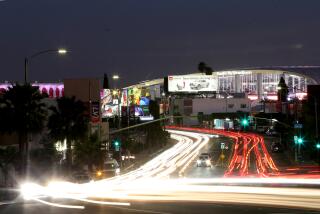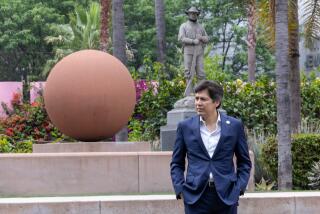True Colors : Glendale Planning Director Hopes for $23,000 to Expand Communityâs Historical View
While Glendale was celebrating its first Historic Preservation Month with promotional movies, tours of pioneer homes and slide shows depicting the glamour of a bygone era, city Planning Director John McKenna said this week that he hopes to expand the cityâs view of itself to include stories of native Indians, immigrants and women.
McKenna said he has requested $23,000 from the councilâs upcoming city budget for city-sponsored history programs, including commissioning of a oral history project.
âHistory is more than just preservation of property, and by looking at our history only through our buildings, we perpetuate the predominance of white males in our recollection of our past,â McKenna said after Mondayâs Historic Preservation Commission meeting.
âYes, we need to preserve old buildings, but we are embarking on an ambitious and valuable program of providing education to schoolchildren and city employees,â he said. âWe need to take a tougher look at ourselves without flinching.â
Since 1988, McKenna has served as a liaison between the city and the commission, with the Planning Department funneling funds and providing staff guidance to the five-member preservation board. The commission was formed in 1986, initially under the Public Works Department, nine years after the city adopted a Historic Preservation Element to its General Plan.
One of the commissionâs first changes since it began working with the Planning Department was expansion of the traditional Historic Preservation Week into a monthlong celebration.
Among the activities planned this month are historic hikes and car rides, exhibits at the central library and City Hall, the unveiling of a commemorative plaque, movies, slide shows and open house tours of the cityâs historic monuments.
McKenna said many historical organizations tend to eschew the more unpleasant aspects of the past, depicting a âfantasy . . . something that was never real.â
He said this is not the case in Glendale. âI think the people in this commission have a little tougher view of history.â
Vonnie P. Rossman, commission chairwoman, said she does not notice a bias in the cityâs recollection of its past. âI donât care if our city fathers are pink, yellow or blue. I never stopped to think about it.â
Attention to Indians
She did say, however, that more attention should be paid to the American Indian population that lived in what is now Glendale before the city came into being. âThere were many Indian tribes in this area, but we donât have anything left over: a few baskets and thatâs it. . . . I donât know how weâre going to do the research, but weâre going to do it.â
McKennaâs wider view of the cityâs history was not in evidence Monday evening as Rossman took about 40 history buffs through a tour of the past with a movie and slide show illustrating the traditional view of Glendale history.
A similar version of city history, recorded in the Historic Preservation Element, makes no references to minorities after the turn of the century and only mentions by name the women who were wives of highly recognized city pioneers--people such as L. C. Brand and E. D. Goode, who together founded most of the institutions and services that have helped Glendale become what it is today.
âTown of Immigrantsâ
âBut Glendale has always been a town of immigrants,â McKenna said. âItalians, Armenians, they have all been here for generations, not to mention the American Indian tribes that were here in the first place, and the Hispanic and Mestizo dwellers. Not all the early settlers were college-educated men from New England.â
As for the women, McKenna said preservationists tend to overlook their contributions because the research is based on historic dwellings that are registered under the male ownerâs name.
The 1938 promotional movie shown Monday, Harold C. Jewellâs âGlendale on Parade,â refers to working women generically as âgirls,â which was the accepted practice at the time. The film takes an upbeat look at the cityâs pre-World War II services, homes, industries, schools, clubs, golf courses and swimming pools.
No black, Asian or Latino faces appear among the hundreds shown in the film, perhaps a reflection of the uniform ethnic makeup of the city at the time.
Movie Shows Perspective
âWhat the movie showed and what it left out really highlights how this city was viewed in 1938 by the people in power,â said McKenna, who was in the audience.
âFor example, it highlights the cityâs efficient law enforcement practices, but Iâm pretty sure that our Police Department was no different than most others at that time, when policemen acted as arresting officers, prosecutors, judge and jury.â
Because it reflects such views, McKenna said, the film is a vital part of Glendale history. Among his budget appropriation requests, he is asking for funds to enhance and preserve the only copy of the film owned by the city.
McKenna conceded, however, that his intention of adding to Glendale history will be limited to the amount of support he receives from City Council.
Budget Hearings Pending
âWe have to see how far we can go this year, what the priorities are in City Council,â he said. âIâll find out just how sympathetic they are during the budget hearingsâ scheduled next month.
He said that if the council supports his oral history project, he would like to review the Historic Preservation Element to reflect a less-stylized vision of the cityâs evolution.
Glendale is changing, he said, and so should the cityâs self-image.
More to Read
Sign up for Essential California
The most important California stories and recommendations in your inbox every morning.
You may occasionally receive promotional content from the Los Angeles Times.










